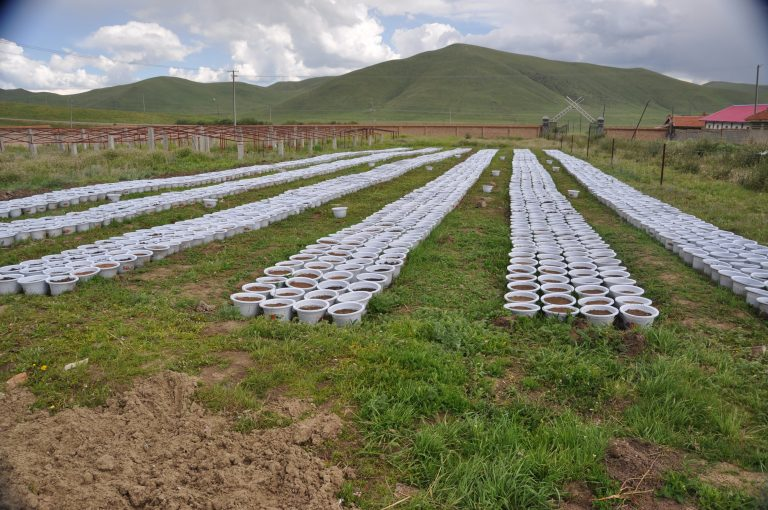Feb 26 2020
Seeds provide a degree of resilience to the adverse impacts of climate change in ecosystems worldwide. Seeds that fall onto the soil usually remain dormant for several years until they are set to develop into plants and, ultimately, become a part of the natural reservoir of seeds in “soil seed banks.”
 A soil seed bank germination experiment in the field consists of collected soil samples, which are spread on pots of sand. As seeds germinate, lead author Miaojun Ma counts and identifies the seedlings. Image Credit: Scott Collins and Miaojun Ma.
A soil seed bank germination experiment in the field consists of collected soil samples, which are spread on pots of sand. As seeds germinate, lead author Miaojun Ma counts and identifies the seedlings. Image Credit: Scott Collins and Miaojun Ma.
The soil seed banks were believed to tolerate the adverse conditions in a much better way when compared to the sprouted vegetation that grows above the ground.
Now, a new study explores how increased precipitation, namely, snow and rain, and warming have an impact on the seeds that fall on the ground of the Tibetan Plateau and in all other places. The study was published in the Ecological Society of America’s Ecological Applications journal.
Soil seed banks are essentially the last resort of natural resilience in ecosystems. Too often we focus on what we see above ground and base management decisions just on the appearance of the plant community.
Scott Collins, Study Author and Professor, New Mexico University
The Tibetan Plateau is a location that has been grazed for centuries. It is a perfect place to analyze both the indirect and direct impacts of climate on vegetation in a delicate setting.
According to the study, the Tibetan Plateau is the highest in the entire world and averages more than 12,000 feet (4000 m) in elevation. It is considered the third pole of the Earth. The rate of warming at the plateau is almost 1.5 times that of global warming because of climate change, and most regions of the plateau experience increased annual rainfall.
Because the growing season is comparatively short on the Tibetan Plateau, the plant surveys and soil samples were all done and collected in just a single year.
Scientists from Lanzhou University based in China visited a total of 57 sample collection locations at different types of ecosystems and elevations in the northeastern region of the Tibetan plateau.
The scientists subsequently collected as many as 1026 soil samples and examined the plant community that grew above the ground. This community included the grown plants, reflecting the types of seeds that fell on the ground over time. The scientists then germinated the samples and cultivated them in experimental plots to analyze the growth and the type of conditions that impact Tibet’s seed soil banks.
Although certain plants seem to grow well under warming and increasing precipitation, these variations were found to have different adverse effects on the tiny seeds that remained resilient and dormant in the soil.
Climate change affects the ability of seeds to germinate, grow and survive. Although climate change affects adult plants, seedlings are delicate and stress from climate—drought, freezing, etc.—can cause high mortality of seedlings.
Scott Collins, Study Author and Professor, New Mexico University
According to the study, the temperature is a major factor in regulating the dormancy of seeds. With rising temperatures, seeds can be stimulated to germinate too soon, especially when conditions are not favorable for their healthy growth.
Warm spells are turning out to be more common than ever before. If an unusually warm spell of several days occurs during an otherwise extreme winter, it would stimulate those seeds to grow but would cause them to fail eventually. Higher moisture levels in the soil may also trigger a majority of the seeds to germinate too soon.
Increasing precipitation and temperatures can also have an indirect impact on the seeds by altering the setting around them. Wetter and warmer soil conditions can encourage abundant growth of pathogens (tiny disease-causing organisms) that are dangerous to seeds. Soil acidity can also vary, which has a strong impact on bacterial communities and the abundance of those microbes.
Additional nitrogen in the soil was also caused by varying conditions. This enables certain species of plants to dominate others and causes a decline in the overall diversity of species, leading to a lower diversity of seeds in the ground.
According to Collins, the research should push ecosystem scientists and managers to focus more on the direct and indirect impacts of global environmental change on belowground systems.
Even when the aboveground community seems badly degraded. The soil seed bank may still provide an important but underappreciated source of ecosystem resilience following prolonged disturbance.
Scott Collins, Study Author and Professor, New Mexico University
But with constant changing climate conditions, that level of resilience continues to be analyzed.